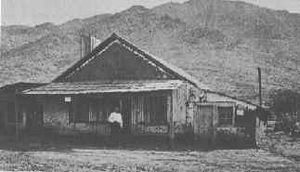Stanton, Arizona facts for kids
Quick facts for kids
Stanton
|
|
|---|---|

Chuck Stanton in front of his store.
|
|
| Country | United States |
| State | Arizona |
| County | Yavapai County |
| Population | |
| • Total | ~3,500 |
| Time zone | MST (no DST) |
| Post Office opened | March 5, 1875 |
| Post Office closed | June 15, 1905 |
Stanton is a small, populated place in Yavapai County, Arizona. Today, it is used as a park for RVs. This area was once a busy stop for stagecoaches, first called Antelope Station. Later, it was renamed "Stanton" after a businessman named Chuck Stanton, who became important in the 1870s. Stanton is about twenty miles north of Wickenburg. It is near the bottom of Rich Hill and close to the old, deserted towns of Octave and Weaver.
Contents
History of Stanton
The Discovery of Gold
The town of Stanton, along with Octave and Weaver, exists because gold was found nearby in 1863. A group of pioneers discovered it. The group was led by a frontiersman named Pauline Weaver. They were camping by Antelope Creek when one of the men, a tracker named Alvaro, went looking for a runaway burro.
Alvaro climbed to the top of what is now called Rich Hill. There, he found a pile of gold nuggets. People said the nuggets were "as big as potatoes." Soon after, Pauline Weaver and his friend Jack Swilling found more gold. They found it on top of nearby Antelope Hill. Weaver said there was so much gold that he could easily dig nuggets out of the ground with a knife. One area of land produced gold worth about $500,000.
Stanton Becomes a Boomtown
The gold discovery in 1863 quickly turned Antelope Station into a boomtown. At first, it was just a small stagecoach stop. But by 1868, about 3,500 people lived there. Chuck Stanton arrived in town a few years later. He quickly worked to take control of the town's businesses.
Stanton first focused on his neighbors, George "Yaqui" Wilson and William Partridge. Both owned a store and a stagecoach stop. In August 1877, Stanton tricked Partridge into a conflict with Wilson. Partridge was arrested and sent to prison.
After Wilson and Partridge were no longer a problem, Stanton turned his attention to John Timmerman. Timmerman had partnered with a family man named Barney Martin. Stanton arranged for his associates to attack Timmerman and Martin in the desert. Sadly, Barney's wife and two young sons were also harmed in this event. This became known as the "Martin Family Incident." Stanton was arrested for these actions. However, due to some people giving false statements, the charges against him were dropped. Later that year, Stanton was killed by a man named Lucero. He was buried about a mile outside of town.
Life in Stanton and Its Decline
Even after Chuck Stanton's death, the town continued to do well for several years. However, it was still seen as a wild place. For example, in 1892, a newspaper from Prescott joked that people in Stanton liked to "fight mountain lions."
By the 1890s, Stanton was a real community. It had miners, their families, a general store, a mill for processing ore, a hotel, and other buildings. For some reason, the town's name was officially changed back to Stanton in 1896. But the town did not last much longer. By 1905, most of the gold in the area was gone. That same year, the Stanton Post Office closed for good, and the town was abandoned.
Stanton Today
In the late 1950s, The Saturday Evening Post magazine bought the ten-acre town. They then gave it away as a prize in a contest. The new owners did not know what to do with the town, so they sold it. Stanton remained empty until the late 1960s. At that time, some hippies moved in and used the old wooden buildings for firewood.
In 1976, the Lost Dutchman's Mining Association (LDMA) bought the property. Since then, they have used the town as an RV park for their members. It is open for six months each year. The LDMA has fixed up some of the town's original buildings. These include Chuck Stanton's old store, an old saloon and dance hall, and a hotel. The town jail is also still standing. Work has also been done to restore the town's old pioneer cemeteries.

